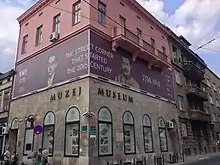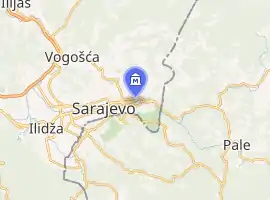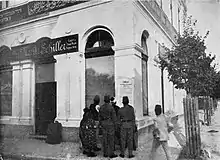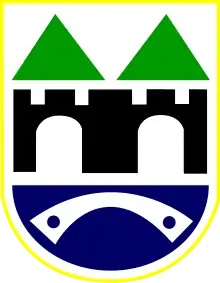Museum of Sarajevo 1878–1918
The Museum of Sarajevo 1878–1918 (Bosnian, Croatian and Serbian: Muzej Sarajevo 1878–1918 / Музеј Срајево 1878–1918) is located near the Latin Bridge in central Sarajevo, the capital of Bosnia and Herzegovina. The building had been Moritz Schiller's Delicatessen in 1914, the year that Franz Ferdinand, the heir-presumptive of Austria Hungary was shot dead by Gavrilo Princip from the street corner outside, indirectly starting World War I.
 | |

| |
| Location | Sarajevo, Bosnia and Herzegovina |
|---|---|
| Coordinates | 43°51′28.46″N 18°25′44.12″E |
| Website | www.muzejsarajeva.ba |
Museum
The permanent exhibition holds a collection of items and photographs with which the museum presents a chronological history of Austro-Hungarian rule in Bosnia and Herzegovina. It is divided into thematic units:
- Resistance to occupation
- Administration and cultural life
- Cultural and religious-educational societies, printing houses and publishing
- Industry and architecture
- The effect of Austro-Hungarian annexation of Bosnia and the Bosnian Parliament
- The Assassination of Crown Prince Franz Ferdinand and his wife Sofia leading to World War I.
Given Princip's often widely differing perception to different parts of society (freedom fighter to many Serbs and pan-Yugoslavs, terrorist forerunner of Karadzic[1] to some Bosniaks), the museum tends to downplay the historic significance of the building despite its location being the main draw for many visitors.
.jpg.webp)
Princip's Gun
To the disappointment of some visitors, the pistol on display in the museum is a replica, not Princip's original. Shortly after the assassination, his actual gun was given, along with the Archduke's bloody undershirt, to Anton Puntigam, a Jesuit priest who was a close friend of the Archduke and had given the Archduke and his wife their last rites. The pistol and shirt remained in the possession of the Austrian Jesuits until they were offered on long-term loan to the Museum of Military History in Vienna in 2004. It is now part of the permanent exhibition there.[2]

Princip's 'footsteps' and memorial plaques
As the corner outside the museum building marked the point from which Princip had launched his attack, it has been the site of several memorials to the event, most of them short-lived.[3] These include a pillar, errected in 1917, but destroyed the following year.[3] In the 1940s a plaque appeared but that was removed when the German Army invaded.[3] After World War II, a new plaque was introduced along with 'footprints' set in the concrete of the pavement outside, very visually marking the point where Princip fired the fatal shots. These were bombed then torn out during the Bosnian War of the 1990s[3] during which time the museum collection was hidden for safe keeping, and the 'footprint set' now on display in the museum is a replica.
To commemmorate the centenary of the assassination, a new plaque was installed in 2014 in small, deliberately neutral, grey[4] stating: "From this place on 28 June 1914, Gavrilo Princip assassinated the heir to the Austro-Hungarian throne Franz Ferdinand and his wife Sofia."[3][5]
External links
References
- Financial Times 2014
- Connolly, Kate (22 June 2004). "Found: the gun that shook the world". The Daily Telegraph. Archived from the original on 20 September 2010. Retrieved 17 September 2010.
- Shapiro, Ari (27 June 2014). "The Shifting Legacy of the Man Who Shot Franz Ferdinand". NPR.org. Archived from the original on 4 July 2019. Retrieved 4 July 2019.
- FT article 2014
- Kuper, Simon (21 March 2014). "Sarajevo: the crossroads of history". Financial Times. Archived from the original on 18 September 2019. Retrieved 8 July 2019.
